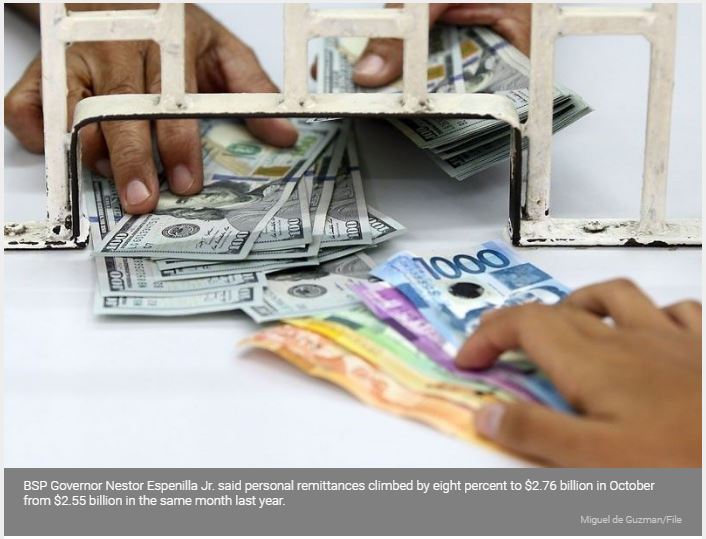Philippines: Remittances up 8% to $2.76 billion in October
MANILA, Philippines — Personal and cash remittances booked their fastest growth in six months, rising by at least eight percent in October as overseas Filipinos continued to send more money to their loved ones in the Philippines ahead of the Christmas holidays, the Bangko Sentral ng Pilipinas (BSP) reported yesterday.
BSP Governor Nestor Espenilla Jr. said personal remittances climbed by eight percent to $2.76 billion in October from $2.55 billion in the same month last year.
This was the fastest growth since the 12.9 percent increase recorded in April this year.
Personal remittances consisting of cash and non-cash items that flow through both formal or via electronic wire and informal channels such as money or goods carried across borders rose by nearly three percent to $26.47 billion from January to October compared to the $25.72 billion recorded in the same period last year.
Espenilla said personal remittances from land-based Filipino workers with contracts of more than one year increased 2.8 percent to $20.3 billion in the first 10 months, while remittances from sea and land-based overseas Filipinos with contracts of less than one year rose 4.2 percent to $5.5 billion.
On the other hand, Espenilla said cash remittances coursed through banks increased 8.7 percent to $2.47 billion in October from $2.27 billion in the same month last year.
The increase in cash remittances in October was the fastest in six months or since booking a double-digit growth of 12.7 percent in April this year.
Espenilla said the top countries that contributed to the growth in October were the US, Canada, and Taiwan, helping reverse the 0.9 percent decline last August and the 8.3 percent drop in September last year.
For the first 10 months, the BSP chief reported cash remittances climbed 3.1 percent to $23.77 billion from $23.05 billion in the same period last year.
Remittances coursed through banks from land-based Filipino workers rose by 2.5 percent to $18.7 billion from January to October, while those coming from sea-based workers went up 4.2 percent to $5 billion.
Espenilla said 79 percent of the cash remittances came from the US, Saudi Arabia, United Arab Emirates, Singapore, Japan, United Kingdom, Qatar, Canada, Germany, and Hong Kong.
The BSP has lowered the growth targets for both personal and cash remittances to three percent from the original target of four percent this year.
The amount of money sent home by Filipinos abroad usually pick up during the ‘ber’ months or the start of the fourth quarter ahead of the celebration of Christmas.
Remittances usually fuel personal consumption, helping sustain a steady economic growth. The amount of money sent home by overseas Filipinos usually account for 10 percent of gross domestic product (GDP).
Chidu Narayanan, economist for Asia at Standard Chartered Bank, said overseas remittance growth would remain steady in 2019, averaging three to five percent year-on-year.
“Growth in remittances is likely to stabilize in the low single digits over the medium term as growth moderates in the West and growth in overseas Filipino workers faces a structural slowdown,” Narayanan said.
Narayanan said remittances would continue to add more than six percentage points to the current account surplus as a percentage of gross domestic product (GDP) in the medium term.
The economist said tourism potential is likely to remain under-tapped in the near term, with tourism receipts at only two percent of GDP.
“We expect an increase in 2019 as tourist destinations that were shut down for clean-ups this year are reopened,” he said.
Source: https://www.philstar.com/business/2018/12/18/1877836/remittances-8-276-billion-october#oqK35Sk67C6B2DKC.99


 English
English




